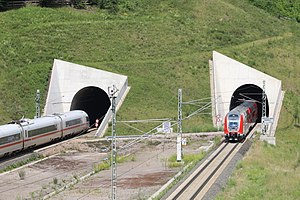Falkenberg tunnel
|
Falkenberg tunnel Falkenberg tunnel
|
||
|---|---|---|
|
West portals
|
||
| use | Railway tunnel | |
| traffic connection | Main-Spessart Railway | |
| place | Heigenbrücken | |
| length | 2623 m | |
| Number of tubes | 2 | |
| cross-section | 48 m² | |
| Largest coverage | 150 m | |
| construction | ||
| start of building | 2014 | |
| completion | 2016 (shell) | |
| business | ||
| operator | DB network | |
| location | ||
|
|
||
| Coordinates | ||
| East portal | 50 ° 1 ′ 24 " N , 9 ° 22 ′ 47" E | |
| West portal | 50 ° 1 ′ 0 ″ N , 9 ° 20 ′ 45 ″ E | |
The Falkenberg Tunnel (or Tunnel Falkenberg ) is a 2623 meter long railway tunnel between the Laufach station and the Heigenbrücken stop on the Main-Spessart Railway . It was built from 2014 to 2016 as part of the re-routing of the Spessart ramp with two tunnels.
location
The tunnel is around 280 m above sea level. NN at the culmination point of the Main-Spessart-Bahn, crosses under the Eselshöhe mountain range and connects the Lohrtal with the Laufachtal in the Spessart . It is located south of the abandoned Schwarzkopf Tunnel . The eastern tunnel portals are in Heigenbrücken, next to State Road 2317 and next to the platform of the Heigenbrücken stop. To the west, the tunnel ends on the southern flank of the Falkenberg, which gives the building its name.
history
In order to avoid the laborious pushing operation on the Spessart ramp and at the same time to increase the maximum speed on the section of the route, the Federal Ministry of Transport decided on August 28, 2006 to completely re-route the section between Laufach and Heigenbrücken. The decision was based on the Federal Railways Expansion Act , which provided for a new or upgraded line for the Hanau – Nantenbach section. The variant implemented in this way provided for the abandonment of the Schwarzkopf Tunnel.
The official stop for the new tunnel took place on March 6, 2014, the symbolic breakthrough on December 4, 2015. Gerswid Hermann, the wife of Joachim Herrmann , then Bavarian State Minister for Construction and Transport , took over the sponsorship of the tunnel . Commissioning followed on June 19, 2017.
construction
The tunnel consists of two adjacent tubes with elliptical shapes and a watertight inner shell, each with a track. The maximum permitted speed is 150 km / h. The maximum cover is 150 meters. The former railway line is crossed with an overburden of around 25 meters. The north tube is 2623 meters long and the south tube is 2619 meters long. They are connected to one another at intervals of 500 meters by a total of five cross tunnels. The main tubes with a cross-sectional area of around 48 square meters each run largely parallel at a distance of around 27 meters and have an almost constant gradient of 11.75 ‰ to 12.50 ‰ in the direction of Aschaffenburg.
The tunnel tubes have a slab track that road vehicles such as fire engines and ambulances can drive on. The cross tunnels are also passable and equipped with self-closing smoke-tight doors. There are underground extinguishing water tanks at the tunnel portals. There are also rescue stations in the immediate vicinity. The escape routes within the tubes are around 1.2 meters wide, around 2.2 meters high and have a handrail.
construction
The construction companies built the two tunnels mainly using mining techniques. The pipes were broken out in partial cross-sections and then secured with shotcrete . They were driven almost parallel and ascending from west to east and the connecting tunnels were driven from the northern tube following the main drive. The rocks that were penetrated were Heigenbrücken sandstone , crumbly slate and mostly unweathered to moderately weathered diorite . The excavated volume was 480,000 cubic meters. About 50,000 cubic meters were used to backfill the Schwarzkopf Tunnel. The rest was stored in landfills near the route.
Web links
Individual evidence
- ↑ Federal Ministry for Transport, Building and Urban Development (ed.): Green light for the new construction of the Schwarzkopf tunnel . Press release from August 28, 2006
- ↑ Law on the expansion of federal railways in the version of April 29, 2005 (Appendix 1 to Section 1, No. 16) - BGBl . I p. 1138
- ↑ In the morning dew to the mountains to the tunnel construction site . In: DB Welt , 10/2014, p. 11
- ↑ a b alfredkunz.de: project description
- ↑ DB Netze: Expansion of the Hanau – Nantenbach line - an overview of the project by the Schwarzkopf tunnel bypass

